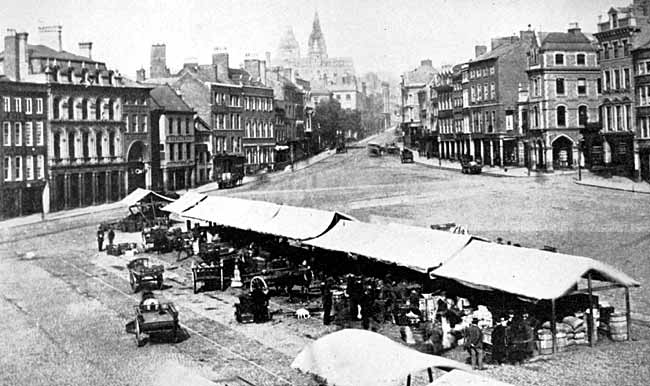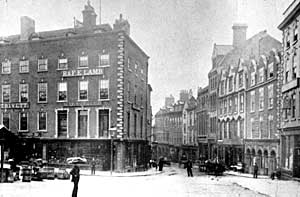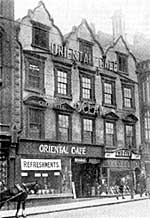< Previous | Contents | Next >
Beastmarket Hill and Wheeler Gate
BEASTMARKET HILL.

Beastmarket Hill in the 1870s.
Beastmarket Hill derives its name from the fact that the cattle market of the town was held hereabouts, but in earlier days it was called Friar Row because along it ran the boundary wall of the White Friars or Carmelites whose story we considered when we were discussing Friar Lane. I think it is probable that an entrance to the Friary would be situated somewhere on Friar Row, but of this nothing definite is known. The foundations of this wall have been disturbed from time to time during building excavations. The last time upon which they were seen, being when Friar Lane was widened in 1923, when at a depth of some five to six feet below the present ground level very considerable remains were discovered. They consisted of foundation walling made of soft local sandstone set in puddled clay and possessed no architectural features which could in any way date them. Associated with this wall and in the area which in ancient times would be occupied by the Friary were traces of various interments, which point to the fact that this area was the burial ground of the Friary, which tends to confirm the opinion that the present building was the church of the establishment. There were also discovered various relics of the daily life of the Friary such as potsherds, tiles and so forth, but unfortunately these have been dispersed and I do not know in whose possession they now are.
It was at the corner of Friar Lane and Beastmarket Hill that stood the mayor's house from which in 1788 the town mace was stolen. Our modern mace was made in 1787, the year after the trial of Warren Hastings, and bears the inscription "Johanne Carruthas Armigero Priside Nottinghamiae."
There are many curious passages leading off Beastmarket Hill, one of which after various twists and turns passes close to the disused Baptist Chapel of St. James and then emerges into St. James's Street. These crooked twisted passages are very characteristic of old Nottingham and show the difficulties under which our forefathers existed. The town was surrounded by a great belt of common land upon which no building was allowed and as the population grew the town itself became more and more congested. Houses were built upon every practicable site and the width of streets and thoroughfares was perforce reduced to a minimum. This is one of the chief factors which led to the erection of so many undesirable houses in the town and which has left to us a legacy of slums and narrow streets and courts so much opposed to modern ideas of sanitation.
In 1800 Mr. John Attenborough lived somewhere on Beastmarket Hill. I do not think that the site of his house has been identified. Mr. Attenborough was the leading medical man of his time in the town. He was one of the prime movers in the hospital and did a tremendous amount of good work. He amply fulfilled the traditions of his profession and did a great deal of work amongst the poor people of the district without any charge, and one of the great benefactions that he conferred upon the town was that he vaccinated free of charge a very great many people and thus saved them from the terrible scourge of smallpox which was so rife in his day.
WHEELER GATE.
 Wheeler Gate from the Market Square in the
1870s.
Wheeler Gate from the Market Square in the
1870s.Wheeler Gate should really be called Wheel Wright Gate, meaning, of course, the street where the wheel makers lived, but in earlier times it had another name for in 1313 it is referred to as Baxter Gate, and it is quite possible that the Baxter House or bake house of the town was situated hereabouts during the 14th century. In this reference of 1313 mention is made of a vine that was growing over one of the houses, the fruit of which was regarded as of considerable value. Outdoor grown vines are by no means common in England nowadays although there are still one or two within the confines of the City of Nottingham, but in times past vines were grown in England with comparative freedom and wine of a sort was made from their grapes. One is frequently reminded of this fact in old documents and plans, and even to-day the well-known house of Compton Winyats, not very far from Stratford-on-Avon, derives its name from the "vinyats" or vineyards attached to it. And again in the great Cistercian Abbey of Beaulieu in Hampshire there is an area attached to the ruins which is called vineyard, while a ruin which stands upon it is called the "Wine Press" and one could mulitiply these references if it were advisable.
Wheeler Gate has always been an important thoroughfare and has carried the traffic from the Market Place to the south of the town. We have seen how down to about 1846 the traffic which had proceeded down Wheeler Gate had to find its way round St. Peter's Church Side and Church Street into Low Pavement and as the street was extraordinarily narrow, not in fact very much wider than Houndsgate, it must have been terribly congested. It was widened in 1885 and again in 1892 when it was put into its present condition, all the demolition being on its eastern side so that the courts and alleys leading towards the west are left pretty much in their ancient condition. It contains some very interesting houses and the site where the Moot Hall public house stands is traditionally said to be the site of the Moot Hall of the French Borough, but I do not think that the evidence for this is conclusive. I think it is more probable that the "Feathers" public house which is so frequently referred to in the Annals of Nottingham stood at this important corner. This "Feathers Inn" reached the climax of its importance in 1688, for it was within its walls that the meeting of the nobility and gentry of the district was held which decided to throw in its lot with William of Orange and his wife Mary, daughter of James II., and so settled for ever the fate of the Stuarts in Nottingham. It was from this meeting that the gentry proceeded to the Malt Cross and made the proclamation which we have already considered.
In 1688 also the Princess Anne came to Nottingham and was entertained in the "Feathers Inn" before her final settlement in Nottingham Castle. Upon that occasion as the waiting staff of the inn was found to be inadequate the great Colley Cibber acted in the capacity of a voluntary waiter and was so much impressed with the beauty and wit of the Princess as to be almost overcome. When asked afterwards what his impressions of the gracious lady were, he replied that he was too confused by the honour of waiting upon her to have any clear idea of what she looked like nor could he concentrate himself sufficiently to hear what her conversation was about, in fact all that he remembered of the proceedings was that she turned to him and in a very sweet voice said "a little more wine and water".

The Oriental Cafe in the 1920s.
The house which is now divided into tenements, the lower of which is occupied by Messrs. Armitage as the Oriental Cafe, is of extreme interest to the architectural student for it forms a link which connects the old Gothic traditions of building with the Renaissance type of house. Its upper stories were illuminated by what are perhaps the earliest sash windows in Nottingham and it has very many other features which are of great interest to the antiquary. The wonderful ceiling in the shop is an excellent example of the plaster work of the 17th century and it is more or less contemporary with the publication of Milton's Paradise Lost. As far as I know there is no documentary evidence of the date when this house was built, but I think it is probable that it was erected in the closing years of Charles I.'s reign, and it is believed to have been the town house of the Earl of Mansfield. There seems no proof of this fact, but at any rate, it was firmly held by the late Mr. Harry Gill who knew more about these matters than most people. It has a later association which is extremely interesting for during the terrible times of the Chartist riots, about 1810, it was occupied by a Mrs. King who in addition to being a grocer added to her income by letting rooms, and these rooms above her shop were occupied by the great Sir Charles Napier, the conqueror of Sind. Although he saw a tremendous amount of service his name will be for ever associated with his work in India where he rose to the height of being Commander-in-Chief. Whilst stopping in Mrs. King's rooms he occupied the humbler post of Commander of the troops brought into Nottingham and the neighbourhood to deal with the civil commotions consequent upon the Chartist riots.
Eldon Chambers is another of those queer little backwaters for which Nottingham is noteworthy. It still exhibits certain old houses, some of them with most curious 17th-and 18th-century features, and one of them that is now occupied as the headquarters of the Tramway Department of the Corporation possesses another of those beautiful carved staircases which ought to make Nottingham famous. This staircase is well worthy to be put upon the same plane as that at Bromley House or at Peoples' Hall and it is not very generally known. I think there must have been quite a school of carpenters in Nottingham who made a speciality of staircases, for although differing in detail, they all have a family likeness and their workmanship is exquisite. I have never been able to find out the name of the artist who designed them or who was the craftsman who constructed them.
In 1764 there was a great cheese riot in Nottingham, the populace being of the opinion that the country folk were endeavouring to charge too much for their cheese and so they proceeded to destroy as many of the cheeses brought into the market for sale as they could, a proceeding which seems to me to savour of the conduct of the Wise Men of Gotham. As these cheeses were made wheel shape it was found a delightful occupation to bowl them down hills leading out of the Market Place and Peck Lane and Wheeler Gate were found to be very suitable gradients for this purpose. Mr. Mayor, as in duty bound, endeavoured to interfere and stop the riot and unfortunately, somehow or other he got in the way of one of these cheeses which was bowling along Wheeler Gate at a good pace with a result that he and all his civic dignity was bowled over and brought into the terrible mud which graced Wheeler Gate right through the 18th century.
Nowadays the most noticeable thing in Wheeler Gate seems to be the tram cars and crossing the thoroughfare is a very perilous undertaking so that an account of Wheeler Gate hardly seems complete without some reference to the tramway system of Nottingham. Public omnibuses took their origin about the year 1825 when a cumbrous vehicle known as "La Dame Blanche" started to ply about the streets of Nantes. The idea soon caught on and the first 'bus in London started to ply between Paddington and the Bank in 1829. It was drawn by three horses abreast and pursued a somewhat leisurely course, the fare for the whole distance being 1/- per person. The next development was to provide a long bench down the centre of the roof on which passengers might sit and then the London General Omnibus Company came into being in 1856, tickets for fares being introduced by the London Road Car Company soon after. So early as 1833 attempts at mechanical traction had been made in London and a steam vehicle which was called the Automatum was run between London and Islington. However, this was regarded as a very dangerous step and an Act of Parliament was passed under which it was encumbent that all mechanical propelled vehicles should be preceded by a man carrying a red flag. This, of course, killed mechanical traction and as it remained in force until 1900, motors, either steam or otherwise, had no chance until that date.
The first section of trams to be started in Nottingham were those which ran from St. Peter's Church to Trent Bridge. They were, of course, drawn by horses and in summer a curious low hung vehicle with rows of seats facing the horses and which some of us will remember as the "Toast Racks" were put into operation.
This section of the tramway system commenced operations on September 17th, 1878, and a year later, in
1879, another section was started which ran to Basford, and the struggles of the wretched horses dragging heavy cars up Derby Road must have been very painful to witness, in fact so painful were they that on May 13th, 1880, a steam tram was started to work this route which was found to be exceedingly noisy and dirty, although probably it was by no means as noisy as the modern trams. Other routes followed, such as the Mansfield Road route, Forest Road route, etc., and they were all worked by the old Tramways Company which had to meet the competition of a good many horse-drawn buses of which the best remembered will be those which ran from St. Peter's Church to Bridgford, and the older amongst us will have pleasant recollections of at any rate one cheery-faced, healthy-looking elderly driver, Bertie Wainwright, who used to smile at the world from behind his huge coachman's bouquet which somehow or other he managed to obtain throughout the year. In 1897 the disputes as to who was to keep the roadway on either side of the tramway tracks in order, which had gone on for years betwixt the Tramway Company and the Corporation, culminated in the purchase by the town of the rights of the old company for a sum of £80,000 and immediately preparations were made for the introduction of electric traction. Electric cars were first introduced on the Sherwood route and date from the year 1901. The cars were at first open at the top, but the present pattern of car with a closed upper deck was soon introduced.
